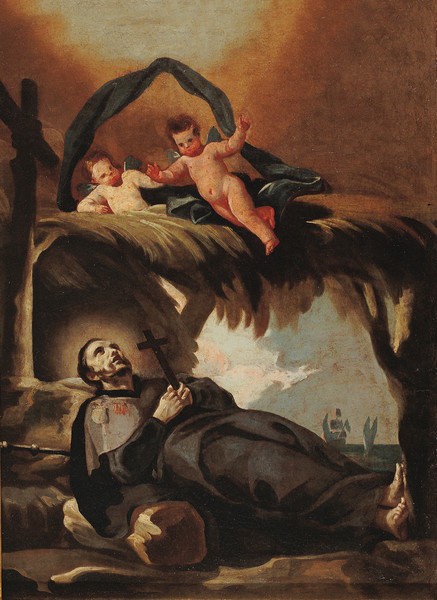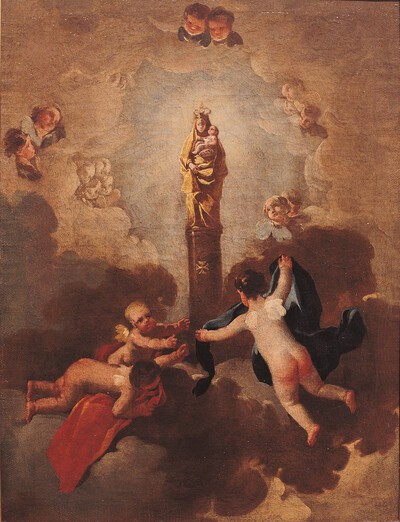- Cronología
- Ca. 1771 - 1774
- Ubicación
- Museum of Zaragoza, Zaragoza, Spain
- Dimensiones
- 56 x 42 cm
- Técnica y soporte
- Oil on canvas
- Reconocimiento de la autoría de Goya
- Documented work
- Titular
- Museo de Zaragoza
- Ficha: realización/revisión
- 07 Jan 2010 / 03 Dec 2024
- Inventario
- (9261)
- Otros títulos:
-
Discovery of the Body of Saint James (Invención del cuerpo de Santiago)
This work was presumably created for one of Goya's relatives as a devotional painting. It was inherited by Ms. Francisca Lucientes, a descendent of his uncle Miguel, his mother's brother.
The Museum of Zaragoza acquired the canvas from the Lucientes family in 1926, together with another dedicated to the Virgin of the Pillar.
From December 5th, 2024, and while the Zaragoza Museum remains closed for works, the painting is part of the exhibition 'Goya. From the Museum to the Palace' in the Aljafería Palace in Zaragoza.
This dramatic scene, clearly divided into two sections - upper and lower - bears witness to the death of Saint Francis Xavier in 1552 on the Chinese island of Sangchuan, where he had been abandoned by the Portuguese who used to trade with the Chinese. In the background we can make out a ship, while the dying saint is pictured clutching a wooden cross, lying beneath an improvised shelter of palms guarded by the two putti which dominate the upper part of the canvas.
The work is executed in rapid, flowing brushstrokes. The face and the hands stand out as they are illuminated. The overlaying of light on dark gives depth to the painting.
The painting was acquired by the Museum of Zaragoza under the title Discovery of the Body of Saint James (Invención del cuerpo de Santiago), an incorrect identification based on the pilgrim's cloak worn by the saint and the shell hanging from his shoulder. However, under this cloak the saint wears the habit of the Jesuits, confirming his affiliation with that order.
A preparatory sketch for this painting can be found in the Italian Sketchbook, which proves its authenticity, although the artist did modify the original basic concept.
In terms of the painting's provenance, its identical size and the similarities between the putti in this work and those of the Virgin of the Pillar, also housed in the Museum of Zaragoza, suggest that they are a pair.
The painting has a reddish base which shows through in certain areas of the work. It has been relined.
It underwent restoration work in the workshops of the Museum of Zaragoza, and the severe craquelure which the painting had suffered – as is the case of other paintings from this period of Goya's career, including its companion painting, the Virgin of the Pillar – was corrected.
-
Exposición de obras de Goya y de objetos que recuerdan las manufacturas artísticas de su épocaMuseo de ZaragozaZaragoza1928organized by la Real Academia de Nobles y Bellas Artes de San Luis in collaboration with the Junta del Patronato del Museo Provincial. April 1928cat. 463
-
Goya joven (1746-1776) y su entornoMuseo e Instituto Camón AznarZaragoza1986consultant editorl José Rogelio Buendía. November 21st to December 20th 1986cat. 34
-
Goya (1746 – 1828)Galleria Internazionale d’Arte Moderna di Ca’PesaroVenecia1989consultant editor Antonio Fortún Paesa. From May 7th to July 4th 1989cat. 11
-
Goya. El Capricho y la Invención. Cuadros de gabinete, bocetos y miniaturasMuseo Nacional del PradoMadrid1993from November 18th 1993 to February 15th 1994. Exhibited also at the Royal Academy of Arts, London, March 18th to June 12th 1994 and The Art Institute of Chicago, Chicago, July 16th to October 16th 1994, consultant editors Manuela B. Mena Marqués and Juliet Wilson-Bareaucat. 5
-
Realidad e imagen. Goya 1746 – 1828Museo de ZaragozaZaragoza1996consultant editor Federico Torralba Soriano. From October 3th to December 1st 1996cat. 13
-
Goya e ItaliaMuseo de ZaragozaZaragoza2008organized by the Fundación Goya en Aragóna, consultant editor Joan Sureda Pons. From June 1st to September 15th 2008cat. 202
-
Goya et la modernitéPinacothèque de ParisParís2013from October 11st 2013 to March 16th 2014cat.3
-
Goya y Zaragoza (1746-1775). Sus raíces aragonesasMuseo Goya. Colección IbercajaZaragoza2015cat. 12
-
Goya. From the Museum to the PalaceZaragoza2024cat.95
-
Vie et ouvre de Francisco de GoyaParísOffice du livre1970pp. 77, 91, cat. 173
-
BarcelonaPolígrafa1970vol. I, p. 252, cat. 113
-
L’opera pittorica completa di GoyaMilanRizzoli1974p. 94, cat. 64
-
Francisco de Goya, 4 vols.ZaragozaCaja de Ahorros de Zaragoza, Aragón y Rioja1980-1982vol. I, p. 62 y p. 240 (il.)
-
Goya. El capricho y la invención. Cuadros de gabinete, bocetos y miniaturasMadridMuseo del Prado1993pp. 112, 113, cat. 5 y p. 115 (il.)
-
Goya y Aragón. Familia, amistades y encargos artísticoscol. Col. Mariano de Pano y RuataZaragozaCaja de Ahorros de la Inmaculada de Aragón1995pp. 105, 107 y p. 106 (il.)
-
Realidad e imagen. Goya 1746 – 1828MadridGobierno de Aragón y Electa España1996pp. 72-73 (il.), cat. 13
-
Goya e Italia, 2 vols.ZaragozaFundación Goya en Aragón y Turner2008vol. II, p. 262, cat. 202
-
ParísPinacoteca de París2013pp. 56-57
-
Goya y Zaragoza (1746-1775). Sus raíces aragonesasZaragozaFundación Goya en Aragón, Ibercaja y Gobierno de Aragón2015pp. 128-129
-
Goya. From the Museum to the PalaceZaragozaZitro Comunicación2024pp.94-95

